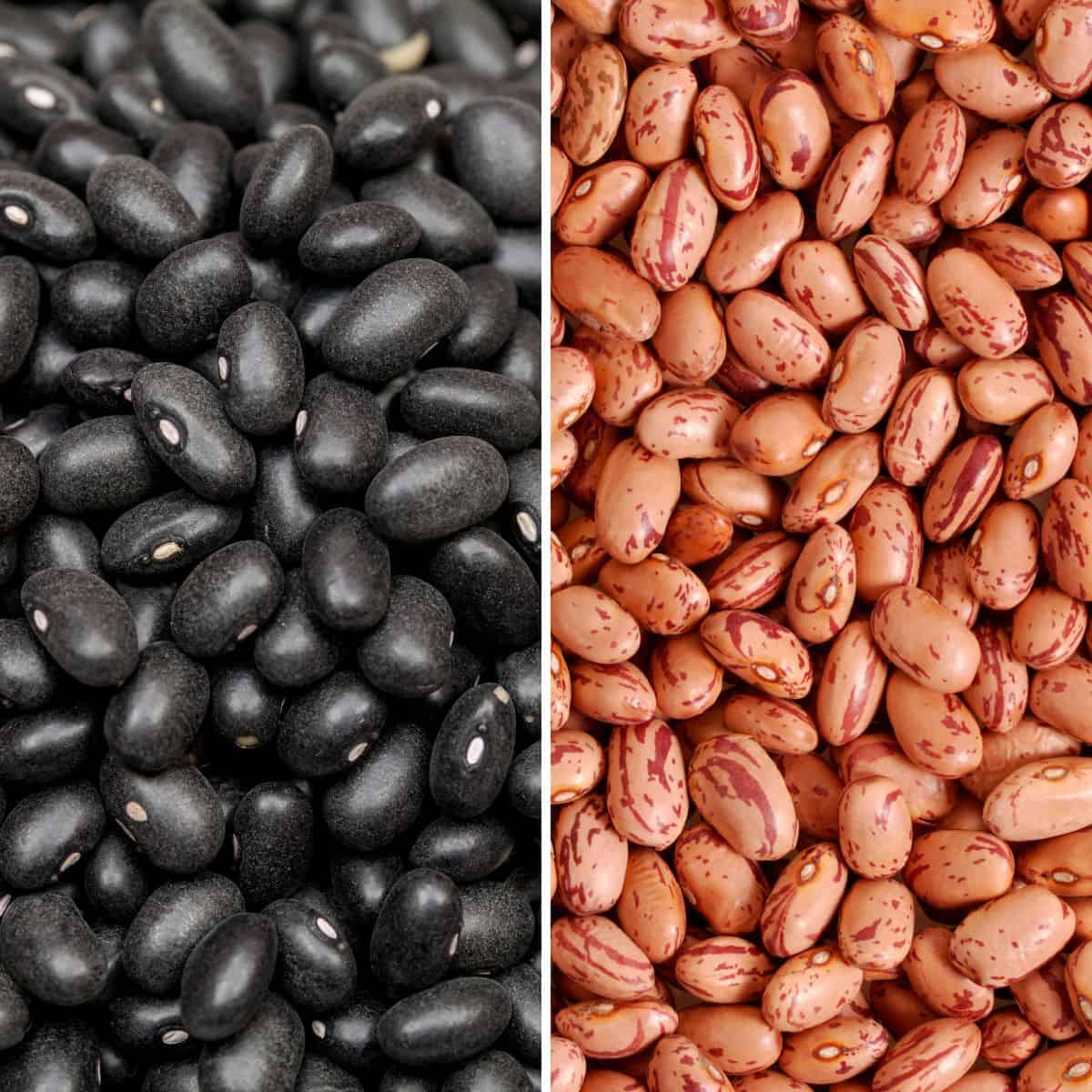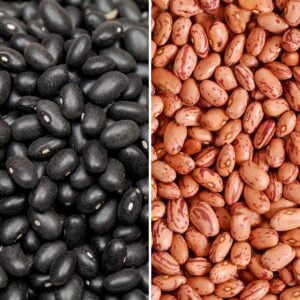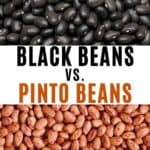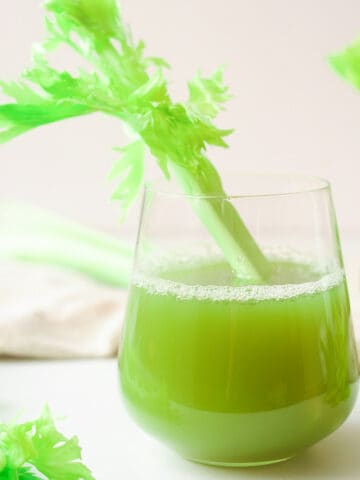Black beans and pinto beans are two types of popular legumes. What are the similarities and differences between the two? In this post, I review black beans vs. pinto beans, their flavor profiles, texture, cooking techniques, and more so that you can decide which type of bean is best for your intended purpose.

Black beans and pinto beans are popular legumes that are used in a variety of different cuisines. They are both nutrient-rich plant sources. But you may wonder what the difference is between these two common bean types.
Do they have different flavor profiles? Is one better than another in a particular recipe? How does their nutrition content vary? In this article, I will explain the similarities and differences between these two popular beans, including flavor, texture, cooking method, origin, and nutrition comparison. You’ll learn everything you need to know about these two types of beans to make an informed decision when preparing your next recipe.
Flavor Profiles
Black Beans have a dense bite and a strong flavor. They are hearty yet small in size with an oval shape. As the name indicates, they are black. When bitten into, they have a lighter interior color. They are also referred to as the black turtle bean.
Pinto Beans are larger. They have a tan color with speckles of brown. In Spanish, pinto means painted. This refers to the different colors on the outer shell. They have a nutty, earthy, creamy flavor that is milder than black beans.
Texture of Black Beans vs. Pinto Beans
Black beans have a hearty and dense texture, while pinto beans have a creamy texture.
Black beans are great for dips and stews because they hold up well when cooked in a broth or chili. Pinto beans, on the other hand, are excellent for spreads because they are easily mashed together to create a creamy base. That is why they are frequently used to make refried beans or as a filling in burritos.
Cooking with Black Beans and Pinto Beans
You can buy canned black beans or pinto beans or prepare dried beans for your favorite recipes. The taste of both beans is much improved if you prepare dried rather than canned.
If you are preparing dried beans, it is essential to remember to soak them overnight. This helps to soften the beans, which allows them to cook more quickly, but it also reduces and helps to release the sugars in the beans that later cause gas.
Preparing dried black beans and pinto beans is a similar process. The main difference is that pinto beans need to cook longer because they are larger.
How to Prepare Dried Black Beans
Step 1: Rinse and sort the beans, removing any stones or other debris.
Step 2: Add the beans to a large bowl. Cover with 3-4 inches of water above the beans. Soak the beans overnight or for 8 hours at room temperature. Place a dish towel over the top while soaking.
Step 3: Drain the beans from the water they soaked in overnight. Transfer them to a large pot. Cover with 4 inches of fresh water. Bring the water to a boil. Reduce the heat, and simmer for 1-2 hours or until the black beans are softened.
Step 4: Drain excess water, and add to your favorite recipes.
How to Prepare Dried Pinto Beans
Step 1: Rinse and sort the beans, remove any stones or debris, and remove any deformed or shriveled beans.
Step 2: Add the beans to a large bowl, and cover with 3-4 inches of water. Soak the beans overnight or for a minimum of 8 hours at room temperature. Place a dish towel over the top of the bowl while soaking.
Step 3: Drain and rinse the beans. Transfer the beans to a large pot. Cover with 4 inches of water. Bring the water to a boil. Reduce the heat, cover, and simmer for 2-2 ½ hours.
Step 4: Remove the beans from the heat. Drain any excess water. Use in your favorite recipes.
Types of Cuisines
Both black beans and pinto beans can be used in various recipes and types of cuisine. They are both versatile beans with a nice flavor and texture. However, black beans and pinto beans have some differences in the typical types of cuisines they are used in most often.
Black Beans
Black beans are most often used in Latin American cuisine. For example, they are frequently used in Brazil, Cuba, Costa Rica, Nicaragua, Venezuela, and the Dominican Republic, with black beans being at the forefront of some of the most popular dishes in these countries. Some of those dishes include feijoada, Moros y Cristianos, gallo pinto, and pabellón criollo. They are often used to make black bean soup with traditional spices and Southwestern and Caribbean dishes prepared with cajun spices and simmered with onions.
Pinto Beans
Creamy pinto beans are often used in Mexican recipes such as refried beans, burrito filling, and bean dip. In addition, they are also a staple in Brazilian cuisine and are used in many recipes along with rice.
Origin of Black Beans and Pinto Beans
Geographic Location
Both black beans and pinto beans originated in South America.
Black beans were grown in South America but brought to other parts of the world in the early 15th century, most likely through the Silk Road and Spanish Explorers. They then made their way to Europe and Asia. Black beans are frequently used in Indian cuisine.
Pinto beans originate from the South American country of Peru. The beans migrated to Central and North America, likely from trading.
Plant Type
Both black beans and pinto beans are legumes. This means they come from a plant that grows in a pod and produces beans. Other legumes include lentils, peas, and different types of beans like kidney beans and white beans. These same beans can also be used as seeds to grow more plants.
Nutrition Comparison
Black beans and pinto beans are both very nutritious. They are high in protein, fiber, vitamins, and minerals while low in calories and fat. But their nutrition profile varies slightly.
| ½ cup Cooked Black Beans | ½ cup Cooked Pinto Beans | |
| Calories | 115 | 123 |
| Fat | .5 grams | .5 grams |
| Carbohydrates | 20 grams | 22 grams |
| Protein | 8 grams | 8 grams |
| Fiber | 8 grams | 8 grams |
| Sugar | .28 grams | .28 grams |
| Calcium | 23 mg | 39 mg |
| Folate | 128 msg | 147 msg |
| Magnesium | 60 mg | 23 mg |
| Iron | 1.8 mg | 2 mg |
| Potassium | 305 mg | 373 mg |
| Cholesterol | 0 mg | 0mg |
| Phosphorus | 120 mg | 125 mg |
As you can see, black beans and pinto beans have similar calorie and fat counts. As well as the same amount of protein and fiber. The main differences between the two are in the vitamins and minerals they provide. Pinto beans have a slightly higher amount of calcium, folate, and potassium. And black beans have a slightly higher amount of magnesium. Both are nutritious choices to add to your diet!
The health benefits of incorporating beans into your diet, including black and pinto beans, include reduced risk of heart diseases, high cholesterol, high blood pressure, and type 2 diabetes. They are a great source of folate which helps produce healthy red blood cells. Rich in antioxidants, beans can help prevent certain types of diseases. In addition, they can improve your overall gut health and curb your appetite.
Conclusion
Black beans and pinto beans are legumes used in various Latin American, Mexican, Southwestern, and Indian recipes.
Black beans are smaller in size, robust in flavor, heartier in texture, and work best in stews, chilis, and curries. Pinto beans are larger in size, brown in color, mild in flavor, have a creamy texture, and work best as dips, spreads, and fillings for burritos and wraps. Both reigned from the South American region and were brought to other parts of the world through trade routes and explorers.
Each type of bean can be purchased, either canned or dried. Preparing both types of dried beans is similar. Both require soaking overnight and then simmering on the stovetop for two or more hours.
Black beans and pinto beans also have a similar nutritional profile. Both are low in calories and fat while high in protein and fiber. They differ most distinctly in their nutritional content of vitamins and minerals such as potassium and magnesium.
Choosing which bean is best for your recipe depends on whether you’re looking for a sturdy or soft bean. Black beans will hold up well against other ingredients and maintain their shape and texture. However, if you’re looking for a creamy mild, flavored bean that is easy to spread, then opt for pinto beans.
References
More Helpful Food Articles!
Please comment below if you found this article helpful or have any additional questions. You can also follow me on Instagram, Pinterest, and Facebook for more family-friendly vegan recipes!
Recipe

How to Cook Dried Black Beans and Pinto Beans
Equipment
Ingredients
Black Beans Ingredients
- 2 cups black beans
- 5 cups water
Pinto Beans Ingredients
- 2 cups pinto beans
- 5 cups water
Instructions
How to Cook Black Beans
- Rinse and sort the black beans, removing any stones or other debris.
- Add the beans to a large bowl. Cover with 3-4 inches of water above the beans. Soak the beans overnight or for 8 hours at room temperature. Place a dish towel over the top while soaking.
- Drain the beans from the water they soaked in overnight. Transfer them to a large pot. Cover with 4 inches of fresh water. Bring the water to a boil. Reduce the heat, and simmer for 1-2 hours or until the black beans are softened.
- Drain excess water, and add to your favorite recipes.
How to Cook Pinto Beans
- Rinse and sort the beans, remove any stones or debris, and remove any deformed or shriveled beans.
- Add the beans to a large bowl, and cover with 3-4 inches of water. Soak the beans overnight or for a minimum of 8 hours at room temperature. Place a dish towel over the top of the bowl while soaking.
- Drain and rinse the beans. Transfer the beans to a large pot. Cover with 4 inches of water. Bring the water to a boil. Reduce the heat, cover, and simmer for 2-2 ½ hours.
- Remove the beans from the heat. Drain any excess water. Use in your favorite recipes.







Teresa Newman
This was so interesting to read…such fun and great information on two things that frequent my diet.
Sara Welch
Added these to a burrito bowl for dinner and they did not disappoint! Hearty, healthy and delicious, indeed!
Krissy
I’m sending this to my mom because she’s always asking me which one to use!
Stephanie
This is so helpful! I have an iron deficiency and my doctor suggested I eat more beans. I’m embarrassed to say that I don’t know one bean from another! I always just use what the recipe tells me to.
Jacqueline Debono
I love posts like this because I learn a lot and they help me make an informed choice about what ingredients I should use!